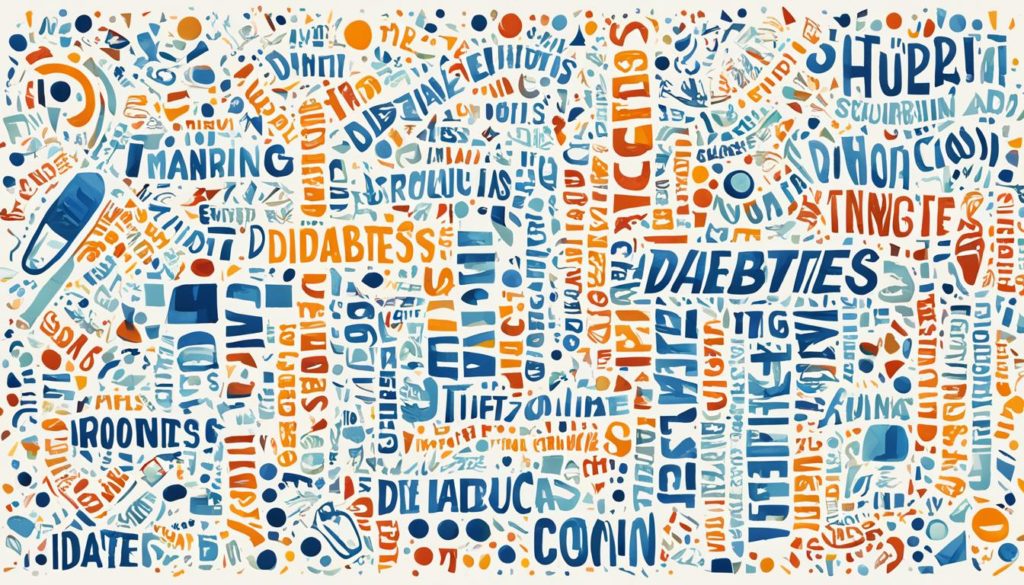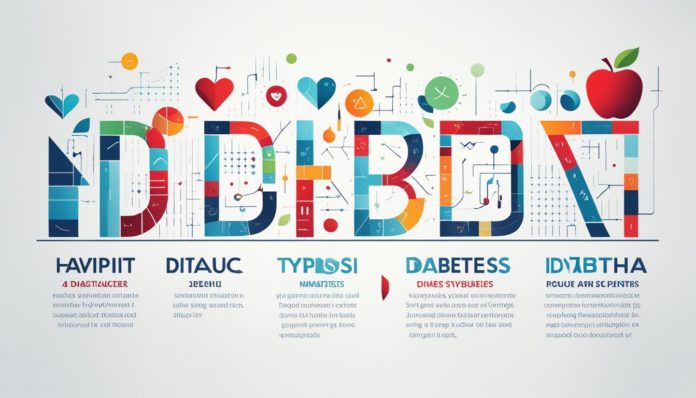About 7.3 million adults in the United States might have diabetes without knowing it. This number from the CDC shows why it’s so important to know the early symptoms of diabetes. Knowing the effective diabetes detection tips is key. It helps find the disease early. This can make life better and stop serious problems later.
Type 2 diabetes slows down how the body uses glucose, leading to high blood sugar. It comes on slowly, so the early signs are hard to spot. Signs to watch for include feeling more thirsty and peeing a lot. You might also feel very hungry, tired, see blurry, have sores that heal slowly, get infections often, and feel numb or have tingling in hands and feet. Spotting these recognizing diabetes early signs is vital for getting the right help fast.
Key Takeaways
- Approximately 7.3 million adults in the U.S. have undiagnosed diabetes.
- Early symptoms of diabetes can be subtle, leading to a delayed diagnosis.
- Key signs include increased thirst, frequent urination, and persistent hunger.
- Fatigue, blurred vision, and slow-healing sores are also early indicators.
- Recognizing these symptoms early can help prevent severe complications.
Understanding Type 2 Diabetes
Type 2 diabetes is a long-term disease affecting how your body handles glucose in your blood. Understanding its key features helps spot early signs and warnings of type 2 diabetes.
What is Type 2 Diabetes?
Type 2 diabetes means your body struggles with insulin. Insulin helps control blood sugar. Over time, if your body can’t use insulin right, your blood sugar stays high.
This can harm your blood system, nerves, and immune defenses, leading to serious health issues. Now, it’s not just adults who get it. More children, especially those overweight or less active, are getting diagnosed.

How Insulin and Glucose Metabolism Work
Insulin is crucial for managing blood sugar. The pancreas makes it to help get glucose into cells for energy. When this system fails, blood sugar levels rise, signaling type 2 diabetes.
Finding these signs early is key to controlling the disease better.
Increased Thirst and Frequent Urination
Experiencing increased thirst along with frequent urination is a common sign of high blood sugar. This problem often shows up in people with type 2 diabetes and those with early prediabetes symptoms.

Causes of Increased Thirst
High blood sugar causes increased thirst. When too much sugar is in the blood, the kidneys try hard to filter and absorb it. If they can’t keep up, they expel the extra glucose in urine. This pulls water from tissues, causing dehydration. So, people feel very thirsty and drink more. This makes them urinate more often.
The Impact of High Blood Sugar on Kidneys
High blood sugar puts a lot of pressure on the kidneys. Over time, this constant pressure can damage them. It’s a serious sign of high blood sugar. Staying hydrated is key. It’s also important to check kidney function often. This helps manage type 2 diabetes or prediabetes symptoms. It can prevent long-term problems and keep kidneys healthy.
Persistently High Hunger
Diabetes often leads to a symptom called polyphagia, or constant high hunger. This happens because people with type 2 diabetes have insulin resistance. Their bodies can’t properly use glucose for energy, leaving cells starved for glucose.
Even after eating, their cells still signal for more energy. This makes them feel hungry all the time.
Why Diabetes Makes You Feel Hungry
To understand diabetes-related hunger, know that our bodies need glucose. With insulin resistance, glucose can’t get into the cells after meals. This makes the body think it’s not getting enough energy, so it keeps feeling hungry.
The Role of Glucose in Energy Production
Glucose is vital for making energy in our bodies. Usually, insulin helps move glucose from food into our cells. But in diabetics, insulin resistance or lack of insulin hinders this process.
Cells don’t get their main energy source, worsening diabetes symptoms like unending hunger.
Fatigue and Low Energy Levels
Diabetes often leads to feeling very tired. This happens because the body struggles to use glucose properly for energy. Also, losing too much fluid from going to the bathroom a lot can make the tiredness worse. It’s important to tackle these symptoms of tiredness from diabetes head-on.
How Diabetes Affects Energy Levels
When cells don’t absorb glucose well, it stays in the blood, making sugar levels high. Because of this, the body can’t get the energy it needs. Plus, diabetes makes you pee more, which can leave you dehydrated. These issues combined lead to the deep tiredness many people with diabetes feel.
Managing Fatigue with Proper Nutrition
Eating right is key to fighting off tiredness from diabetes. A diet low in fat and high in fiber helps keep blood sugar steady. This stops sudden energy dips. Eat whole grains, lean meat, and lots of veggies for balanced meals that boost energy all day.
To beat tiredness from diabetes, it helps to eat smarter, drink plenty of water, and maybe talk to a doctor. Smart food choices can boost your daily energy a lot. They help you handle diabetes better and live a more active life.
Blurred Vision and its Implications
One of the key diabetes vision symptoms is blurred vision. This is a big worry for those with type 2 diabetes. The main cause is the eye’s lens swelling due to high blood sugar.
How High Blood Sugar Impacts Eyes
High blood sugar can make the eye’s lens swell. This changes how well you can see. Vision changes can mess with daily life and happiness.
If sugar levels stay high, they can hurt the blood vessels in the retina. This may cause serious and lasting problems.
Preventing Vision Problems
To avoid vision loss from diabetes, keep your blood sugar in check. Use diet, medication, and get regular check-ups. Spotting and handling vision symptoms early is key to prevent bigger problems.
Slow Healing of Cuts and Wounds
Dealing with diabetes means facing different problems, such as how wounds heal. High sugar in the blood can make it tough for the body to fix cuts and wounds. It’s key to know how to handle diabetes sores well.
Impact of High Blood Sugar on Blood Circulation
Too much sugar in the blood can hurt blood flow. It affects nerves and vessels, making it hard for blood to reach wounds. This slows healing. Plus, bad circulation raises the risk of getting infections, which is another hurdle in treating diabetes sores. For more on these issues, check out this detailed resource.
Steps to Promote Healing
Caring for diabetes sores the right way is vital. Keeping wounds clean avoids infections and helps them heal. Also, watching your blood sugar can prevent it from blocking the healing. Eating well, with plenty of vitamins, assists your body’s repair work.
Understanding the special challenges of diabetes sores is important, too. Talking often with doctors and keeping up with new treatments helps a lot. For extra advice, look at this useful guide.
Tingling and Numbness in Extremities
Feeling tingling and numbness in your arms and legs can be worrying. It often means the first signs of nerve damage in people with diabetes. It’s important to catch and treat these symptoms early to avoid more problems.
Understanding Diabetic Neuropathy
Nerve damage caused by high sugar levels over time is known as diabetic neuropathy. It usually affects the legs and feet. Catching and treating these signs early helps manage the disease and prevents worse damage.
Prevention and Management of Nerve Damage
Dealing with diabetic nerve pain requires looking after your blood sugar and living healthy. For better nerve health, try these steps:
- Check your blood sugar often
- Eat a well-balanced diet
- Stay active regularly
- Take medicines as your doctor says
- See your doctor often
This approach can help lessen diabetic neuropathy symptoms. It can also lead to a better life quality.
Early Signs of Type 2 Diabetes
Knowing the early signs of type 2 diabetes is key to managing it well. These signs can be easy to miss but are important to spot early. Look out for excessive thirst, needing to urinate often, and always feeling hungry.
Don’t ignore chronic fatigue and blurry vision as they are also early signs. Persistent high blood sugar can make cuts and wounds heal slowly. This is another alert, especially for those at higher risk.
Yeast infections and feeling tingling or numbness in your hands or feet are signs too. Paying attention to these symptoms can help catch diabetes early, making treatment more effective.
- Excessive thirst and frequent urination
- Persistent hunger
- Chronic fatigue
- Blurred vision
- Slow-healing cuts and wounds
- Yeast infections
- Neuropathic pain
Understanding and tracking these early signs can help you take charge of your health. It can lessen the long-term effects of diabetes on your life.
Conclusion
Managing diabetes well is vital for those with Type 2 diabetes, especially in poorer countries like India. It’s important to catch it early by knowing the warning signs and getting checked often. This helps to start treatments early, which can stop bigger problems from happening.
To live better with diabetes, it helps to change some things in your life. Eating well, staying active, and keeping a healthy weight are key. Learning all you can about diabetes and how to deal with it also helps people to take better care of themselves.
For deeper details on managing diabetes, check out the full article. And remember, it’s always important to talk with doctors for advice and plans that fit you for a better life.
FAQ
What are the early signs of type 2 diabetes?
Early signs include excessive thirst, frequent urination, and unrelenting hunger. You might also feel very tired, have blurry vision, and slow-healing sores. Yeast infections and neuropathic pain are common too. These signs can be easy to miss, so it’s vital to catch them early.
How can I recognize the symptoms of diabetes?
To spot diabetes early, watch for symptoms like being really thirsty and going to the bathroom a lot. Feeling constantly hungry, tired, having blurry eyesight, and slow to heal cuts are clues. Also, getting infections often and feeling tingling or numbness in your hands or feet are signs.
What is Type 2 Diabetes?
Type 2 diabetes means your body has trouble using sugar from food properly. It happens because your body resists insulin or doesn’t make enough of it. This leads to high sugar levels in your blood, which can cause other health issues.
How does insulin resistance affect glucose metabolism?
Insulin resistance means your body’s cells don’t react well to insulin. This messes up how sugar is used for energy. Your pancreas may also not make enough insulin. This causes your blood sugar to go up.
What causes increased thirst and frequent urination in diabetes?
High sugar levels make you very thirsty because your kidneys are trying to get rid of the extra sugar. This makes you pee a lot. This cycle of being thirsty and peeing can lead to losing too much water from your body.
How does high blood sugar impact the kidneys?
When your blood sugar stays high, it can make your kidneys work too hard. They have to filter a lot of sugar. Over time, this can harm your kidneys. Keeping your sugar levels in check is key to protecting your kidneys.
Why does diabetes cause persistent hunger?
In diabetes, your body can’t use sugar properly for energy, so you feel hungry all the time. Even if you eat, your cells might not get enough sugar, keeping you hungry.
What role does glucose play in energy production?
Glucose is a key energy source for your body’s cells. In diabetes, your body can’t use glucose well. This leaves you with low energy and feeling hungry, even after you eat.
How does diabetes lead to fatigue?
Diabetes causes fatigue because your body can’t move sugar into your cells well. This makes you have low energy. Also, losing water from peeing a lot can make you dehydrated and even more tired.
How can proper nutrition help manage diabetes-related fatigue?
Eating the right foods, like those low in fat and high in fiber, can help level out your blood sugar. This can make you feel more energetic and less tired if you have type 2 diabetes.
How does high blood sugar affect vision?
High sugar levels can make the lens in your eye swell, blurring your vision. If it’s not treated, it can hurt blood vessels in your eye and lead to loss of vision.
What steps can prevent vision problems in diabetes?
To avoid eye issues, keeping your blood sugar in check is key. Have your eyes checked regularly. If you notice any changes in your vision, see a doctor right away to prevent serious problems.
Why do cuts and wounds heal slowly in diabetics?
High blood sugar can make it hard for blood to move around well, harming nerves and blood vessels. This slows down healing if you get a cut or wound, increasing infection risk.
How can diabetics promote better wound healing?
To help cuts heal faster, keep them clean and watch your blood sugar. Getting regular check-ups and proper medical care ensures good blood flow, aiding faster healing for those with diabetes.
What is diabetic neuropathy?
Diabetic neuropathy is when high sugar levels harm nerves. It can cause tingling and numbness, especially in your hands and feet.
How can nerve damage be prevented and managed in diabetics?
Keeping your sugar levels under control is crucial to avoid nerve damage. Changes in your lifestyle, regular check-ups, and treatment can ease symptoms and stop more damage.
Why is early detection of type 2 diabetes important?
Finding diabetes early lets you start treatment soon. Changing how you eat and taking medicine can greatly improve your life. It helps avoid serious problems caused by high blood sugar.


